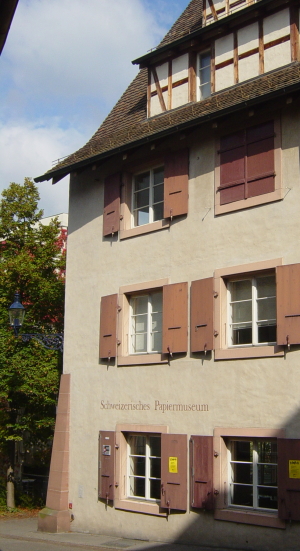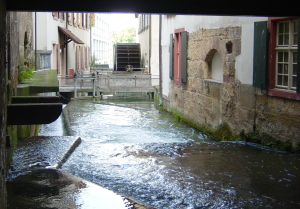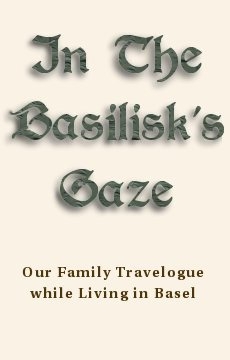Living in a Museum
 Friday, February 20, 2009 at 9:34PM
Friday, February 20, 2009 at 9:34PM We had booked a temporary furnished apartment in Basel through an internet agency, but we had no idea what to expect.  It had been advertised as having 4.5 rooms, and we had confirmed that it had two full bedrooms and a study. We also knew its location and that it was on the second floor with a lift. But beyond these crucial facts we knew little.
It had been advertised as having 4.5 rooms, and we had confirmed that it had two full bedrooms and a study. We also knew its location and that it was on the second floor with a lift. But beyond these crucial facts we knew little.
The apartment turned out to be in a five-century-old half-timber building (pictured here) called the Stegreif Mill, one of two that together contain the Swiss Paper Museum. The adjacent Gallician Mill dates from before 1428, but first became a paper mill in 1453 and now houses the main museum exhibits. Separating the two buildings is one part of the St-Alban Teich, a canal whose water drives a huge antique water wheel. This wheel was mounted directly below our living room window, filling the dining area with the sounds of rushing water as it ground implacably around the massive axle hour after hour. Naturally, this was a hit with Wiki and Loxon. The apartment also had half-views of the Rhine, a projector connected to a Mac Mini, free broadband and an old piano. The other furnishings and fittings were somewhat sketchy, but that just meant fewer things needed rescuing from the twins. Overall, it was a pleasant surprise.
As soon as we had finished the handover and unpacked the car, we headed down to the museum cafe, two storeys directly below us. It wasn’t until we were finished our coffees that we realised we had no Swiss Francs.  As is often the case in Basel, we could have paid in Euros, but Serge the waiter had already seen that we were moving in upstairs, and told us we should simply drop by the next day to pay. Already the Stegreif Mill was starting to feel like home.
As is often the case in Basel, we could have paid in Euros, but Serge the waiter had already seen that we were moving in upstairs, and told us we should simply drop by the next day to pay. Already the Stegreif Mill was starting to feel like home.
Over the next couple of weeks, we spent our time getting oriented, looking for a permanent apartment and teasing out those little details of life in a new country that demand immediate attention: how the parking rules work, where the nearest shops are, which objects in them are actually edible and so on. There were a few challenges associated with our entry status as tourists — Marion’s employer wouldn’t arrange a residential visa until the day she began work — meaning we couldn’t yet register with the canton administration and so couldn’t prove we had a Swiss address. Mark went to the Post Office in the old city a total of four times, trying by various means to join the Swiss car-sharing organisation, Mobility, before he eventually succeeded. Fortunately we had rented the Peugeot for three more weeks, so it was possible to cover ground rapidly and see what areas of the city we liked.
In the process, it became obvious that a car is about the worst way to get around Basel once you know where you are going. The traffic lights are geared to give pedestrians and bikes the quickest passage. In the central areas, many of the streets are one-way for cars (but bikes can go both ways) and priority goes to the highly efficient trams.  Since the city is relatively flat, this means cycling is usually the fastest way to get between any two points, unless there is a direct tram and you are lucky with your timing. Expecting a car to get you somewhere quickly is a recipe for frustration, which is the way it should be in such a compact, quirky city.
Since the city is relatively flat, this means cycling is usually the fastest way to get between any two points, unless there is a direct tram and you are lucky with your timing. Expecting a car to get you somewhere quickly is a recipe for frustration, which is the way it should be in such a compact, quirky city.
The trams were a source of excitement, since we had first seen them in Mannheim. Here they were everywhere, and Wiki took the opportunity, before others realised his plan, to conduct an experiment on them. His method consisted of swinging his balloon into the side of an oncoming tram. The result was the destruction of one piece of his apparatus — you can guess which — and the conclusion was mild distress. But he accepted the empirical evidence bravely, and forgave the tram, eventually.
Not being registered as residents also meant we were forced to use pre-paid mobile phone connections, since we could not sign local contracts. But there was one administrative task that turned out to be unexpectedly easy: setting up bank accounts.  Everywhere else we’ve lived, banks make it tricky for newly arrived immigrants to open an account. Not in Switzerland — not right now, at least. We rang the UBS central branch and were given an appointment with a senior customer advisor later the same day. When we arrived, we were greeted at the door, then ushered into a private meeting room where we were served sparking mineral water. A second customer advisor appeared with a large box of toys, and proceeded to open it for the boys in a corner. After some discrete enquiries about our financial needs, an account structure was proposed with both joint and individual accounts, plus credit cards for each of us, all for a modest monthly fee. To top it off, these fees would be waived for a year, so essentially we would be getting everything we could possibly need for nothing.
Everywhere else we’ve lived, banks make it tricky for newly arrived immigrants to open an account. Not in Switzerland — not right now, at least. We rang the UBS central branch and were given an appointment with a senior customer advisor later the same day. When we arrived, we were greeted at the door, then ushered into a private meeting room where we were served sparking mineral water. A second customer advisor appeared with a large box of toys, and proceeded to open it for the boys in a corner. After some discrete enquiries about our financial needs, an account structure was proposed with both joint and individual accounts, plus credit cards for each of us, all for a modest monthly fee. To top it off, these fees would be waived for a year, so essentially we would be getting everything we could possibly need for nothing.
You know capital is in short supply at a bank when they take your cash for free with no minimum balance, while plying you with mineral water. But I guess there has to be some advantage from the Global Financial Crisis. We walked out an hour later with a complete set of Swiss bank accounts, feeling rather refreshed.
